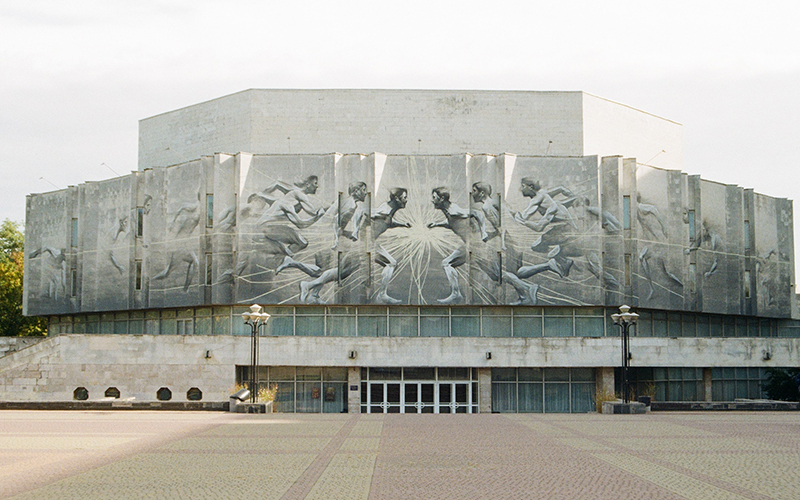What we like
Why Archiving Culture is an Act of Political Resistance

It goes without saying that these are turbulent times—politically, historically, economically, emotionally.
In times of crisis, the arts are amplified for their humanizing, and uplifting, powers. This video of a violinist performing for frightened and exhausted families hiding in an underground bomb shelter in Ukraine’s besieged city of Kharkiv exemplifies art’s power to heal and offer hope. But, in wartime, the arts are also a prime target for enemy attacks.
For example, paintings by the celebrated Ukrainian artist Maria Prymachenko came under literal fire as a museum 50 miles outside of Kyiv was bombarded and destroyed by Russian forces. Considered an iconic self-taught artist whose work epitomizes Ukraine’s national identity through her depictions of folklore and “traditional Ukrainian motifs,” as described by an article published by CNN, Prymachenko was revered throughout Europe by famous artists including Pablo Picasso. Fourteen of her paintings were allegedly taken from the museum by a Ukrainian civilian for “safekeeping” prior to the attack, but their whereabouts are currently unknown.
Ukrainian lawyer Natalia Gnatiuk, who is also a partner of the Maria Prymachenko Family Foundation, was quoted by CNN as stating, “[The museum] was the first building (destroyed in Ivankiv) and the task of the occupants is to destroy our Ukrainian roots, to destroy our Ukrainian culture — they hate it.” She goes on to identify Maria Prymachenko as “not only the symbol of Ivankiv … and not only the symbol of Ukraine but a symbol of the whole world today.”
When a country is invaded, such as Ukraine, their culture literally becomes a target for destruction. As noted in the New York Times, “Across Ukraine, scores of historic buildings, priceless artworks and public squares are being reduced to rubble by Russian rockets, missiles, bombs, and gunfire.” What happens to a society when museums and other cultural institutions are reduced to smoldering rubble? It’s a rhetorical question, of course, but the answer is so inhumane—essentially an act of cultural genocide—that it’s almost unthinkable.
Today, the technology exists to preserve the artistic achievements of countries, cultures, and individuals—even if those same groups are under active attack.
Digitization of historical archives and precious cultural objects means artifacts can resist the threat of total annihilation wrought by militaristic campaigns.
In fact, as reported by Artnet, a group of digital humanities experts has stepped up and formed an alliance to undertake the massive task of digitally preserving as much of Ukraine’s cultural heritage as possible, while the country attempts to fight off its Russian invaders. This initiative, entitled SUCHO, for Saving Ukrainian Cultural Heritage Online, was spearheaded by Quinn Dombrowski, a technologist from Stanford University, Anna Kijas, a librarian at Boston’s Tufts University, and Sebastian Majstorovic, a digital humanities expert at the Austrian Center for Digital Humanities and Cultural Heritage.
According to Artnet, “Since launching on March 1, SUCHO has made digital archives for more than 1,500 websites, digital exhibits, open access publications, and other online resources from Ukrainian cultural organizations, for a total of three terabytes of data as of Wednesday (March 9th).”
Digitizing cultural artifacts, however, is not only the work of librarians and academics.
Artists can also utilize technology to preserve the legacies of cultural heritage. The Iranian artist Morehshin Allahyari received global recognition and praise for her work Material Speculation: ISIS (2015-2016), which the artist describes as:
“…a 3D modeling and 3D printing project focused on the reconstruction of 12 selected statues from the Roman period city of Hatra and Assyrian artifacts from Nineveh that were destroyed by ISIS in 2015 in a series of highly-publicized YouTube videos. The series goes beyond metaphoric gestures and digital and material forms of the artifacts by including a flash drive and a memory card inside the body of each 3D-printed object.”
Essentially, Allahyari worked with activists on the ground in Iran to compile scans and other documentation of these 12 statues that were destroyed by ISIS. She then took that data and transformed it into 12 3D-printable files—miniatures of each sculpture.
A flash drive containing significant cultural data relative to each sculpture was then embedded in the final 3D printed miniature. This data includes “images, maps, PDF files, and videos gathered on the artifacts and sites that were destroyed,” according to the artist.
Allahyari writes that “Material Speculation: ISIS creates a practical and political possibility for artifact archiving, while also proposing 3D printing technology as a tool for resistance and documentation.” She believes these works are both time capsules and living archives, that will be protected as well as accessible to future generations.
Artwork Archive strongly supports the artists and institutions working to preserve artistic and cultural legacies through digital, archival activities.
One such artist is Olena Kharchyshyna—a painter from Zhytomyr, Ukraine—whose work is archived and published online via her Artwork Archive public profile.
Perhaps now more than ever before, we have both the urgent need and the technological means to proactively safeguard cultural heritage for future generations. Otherwise, we will lose more than our artworks, our artifacts, and our national narratives—we will lose our culture, our history, and our humanity.


